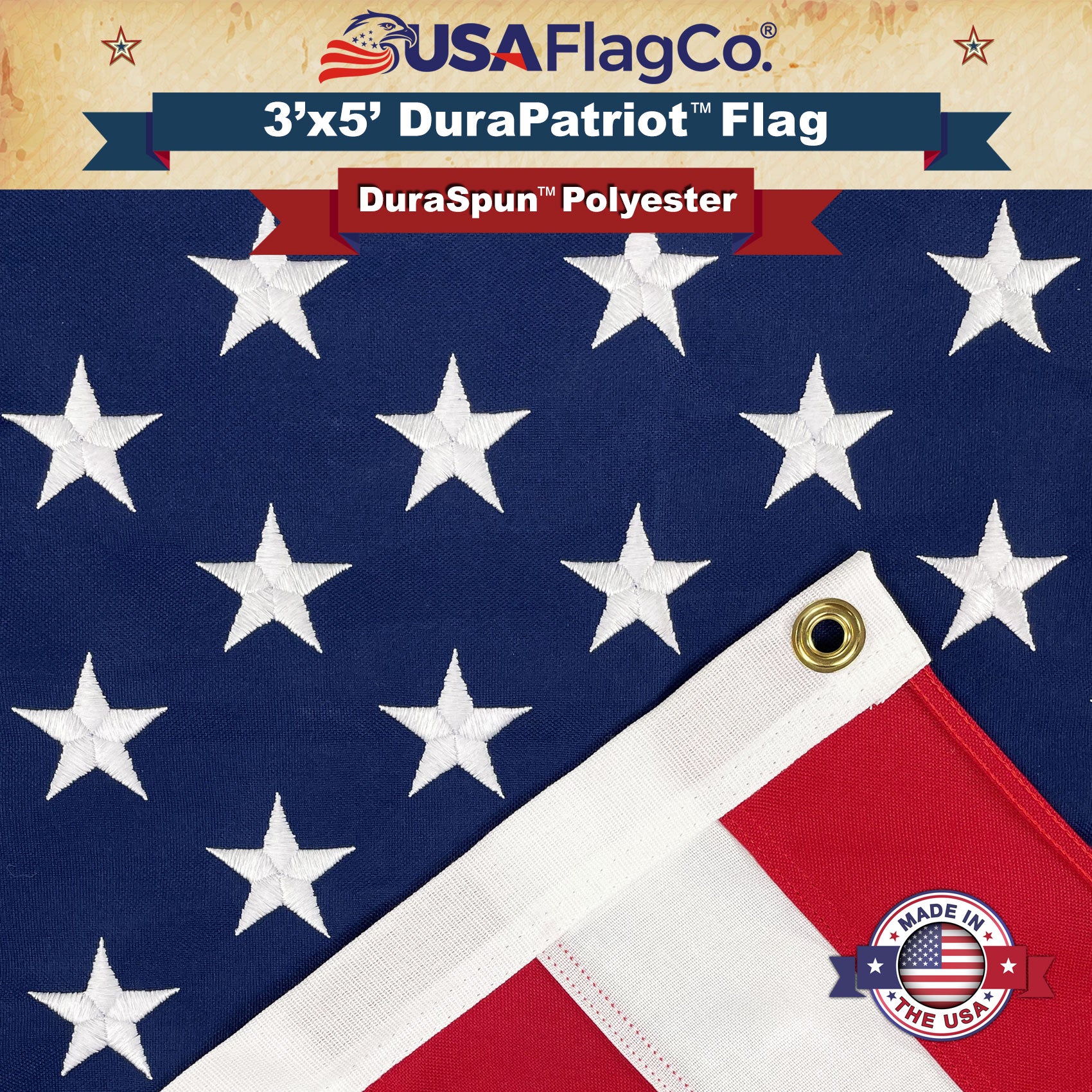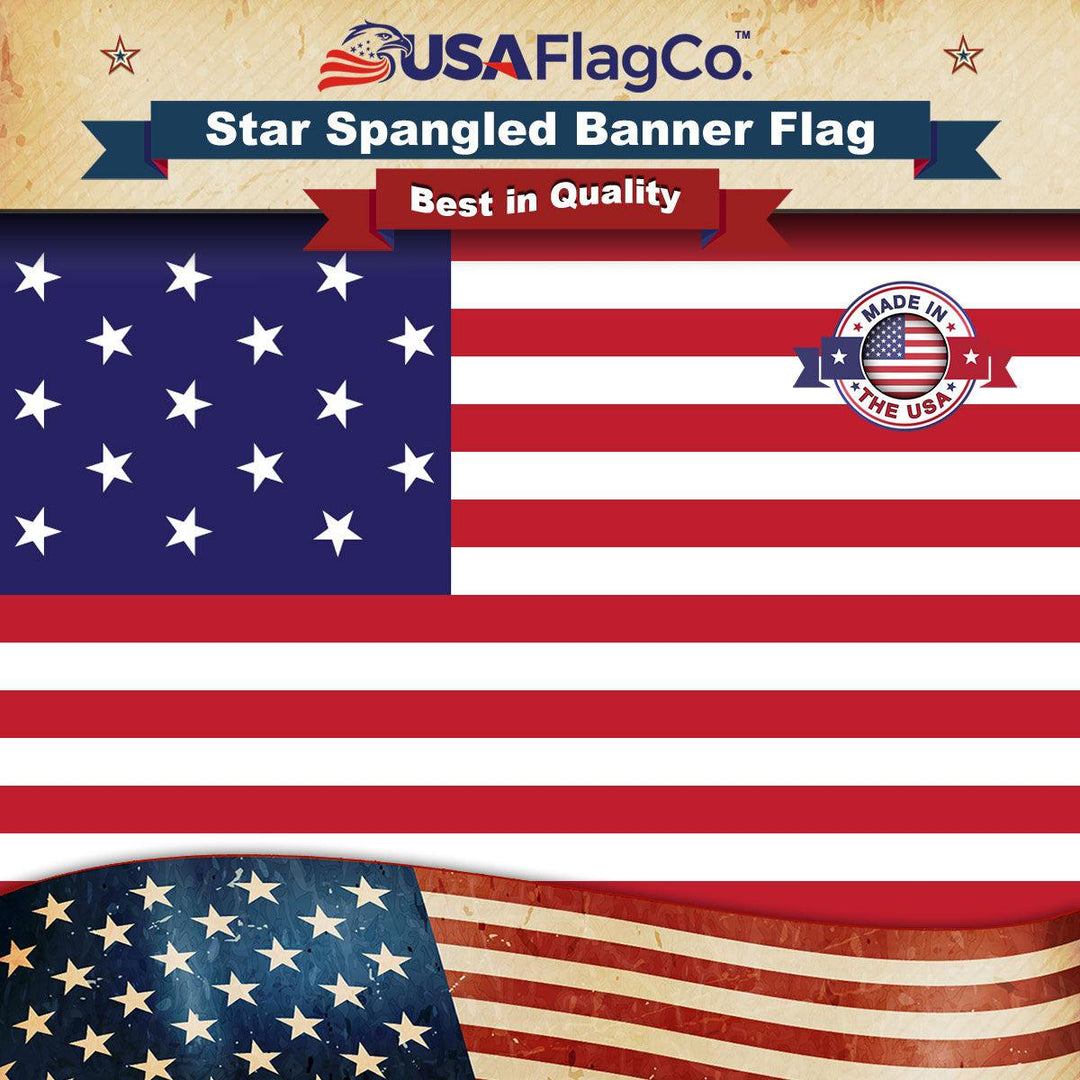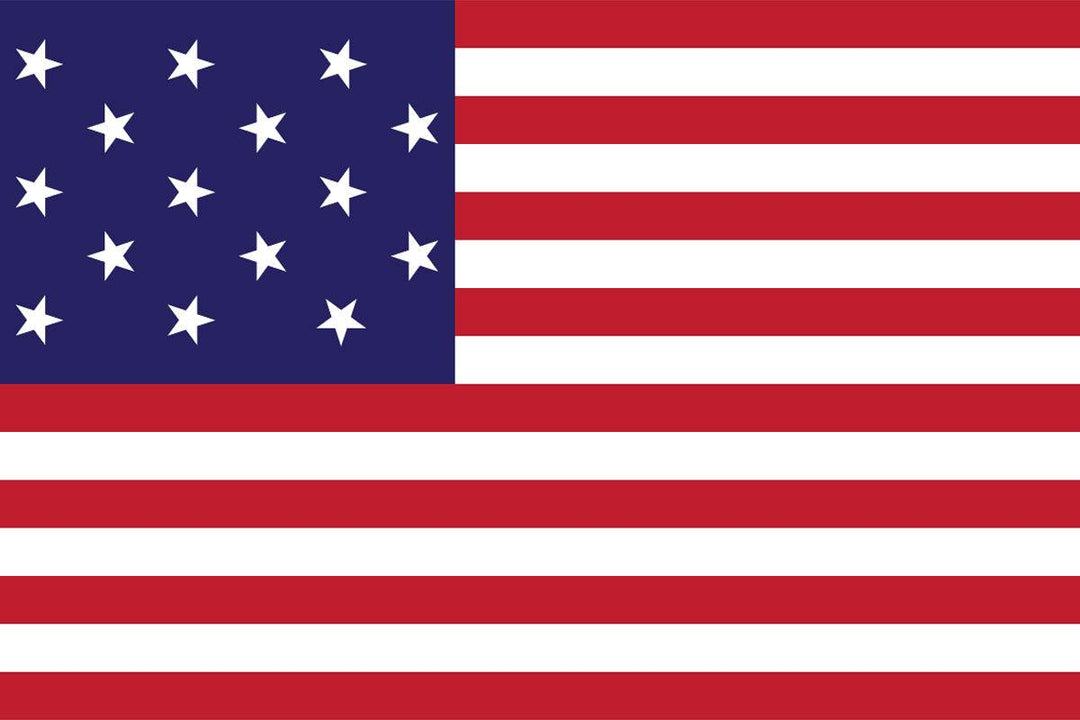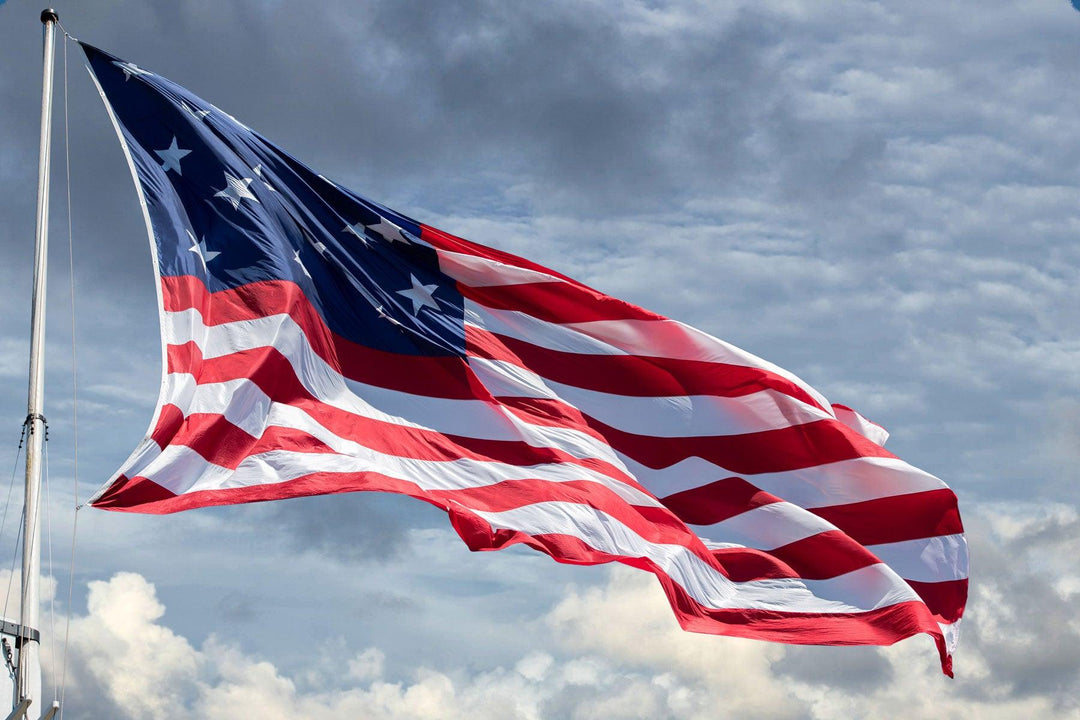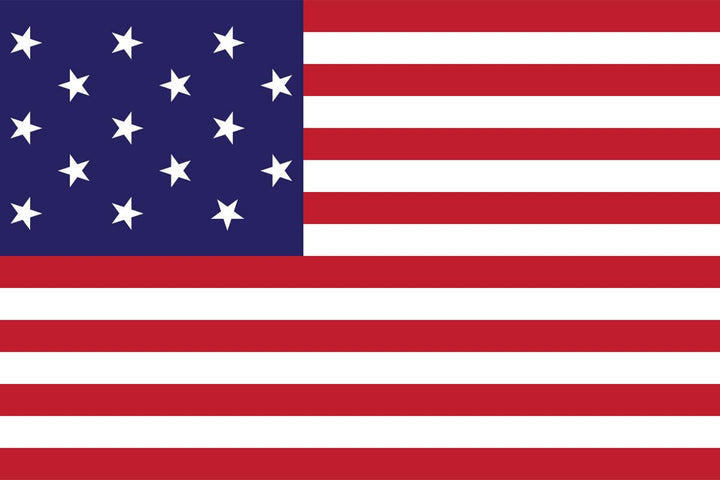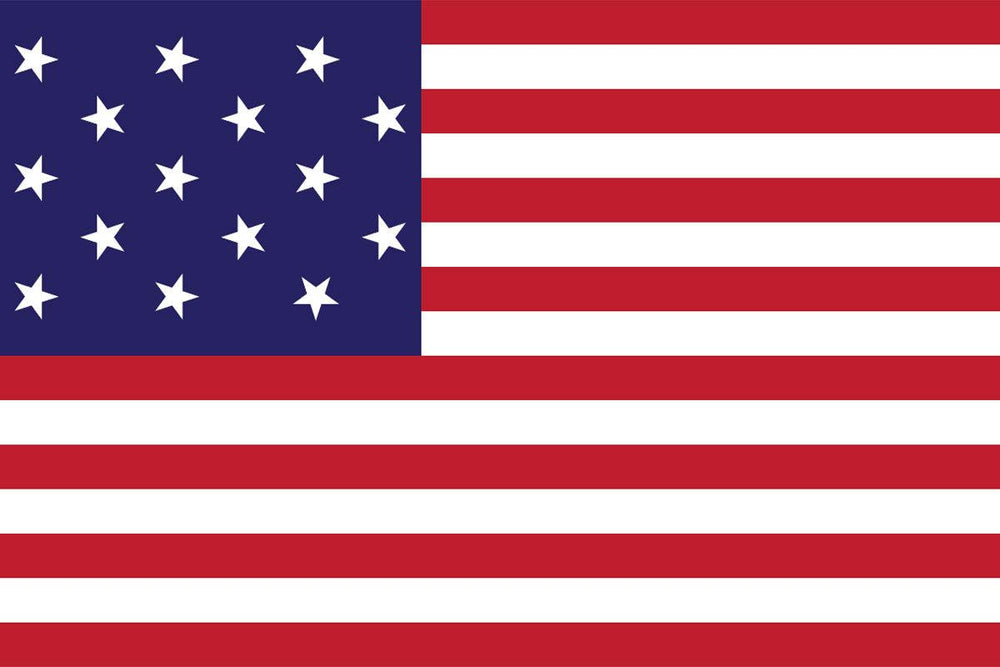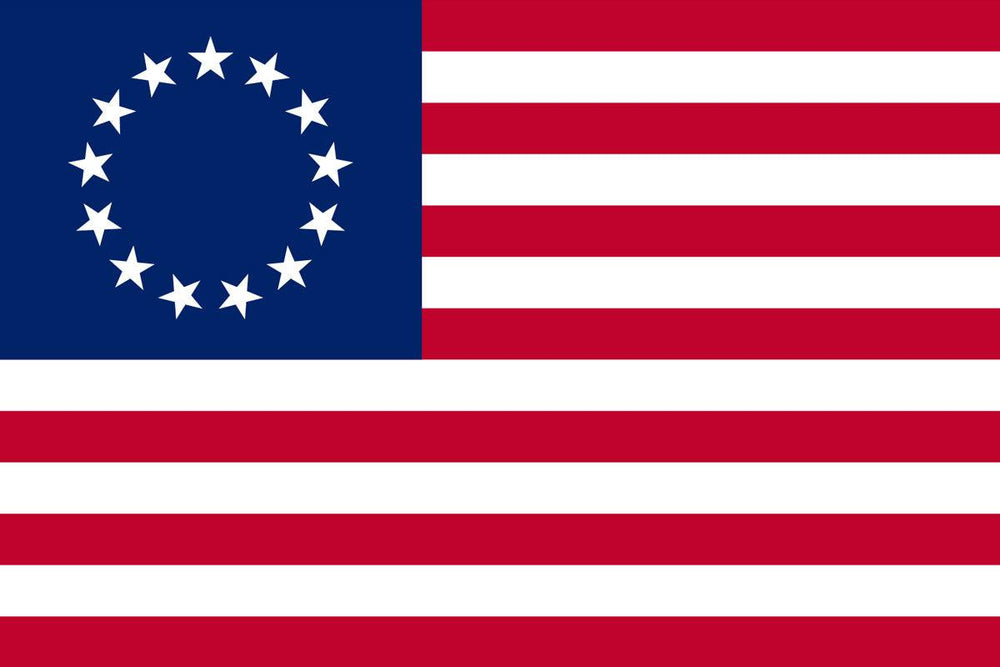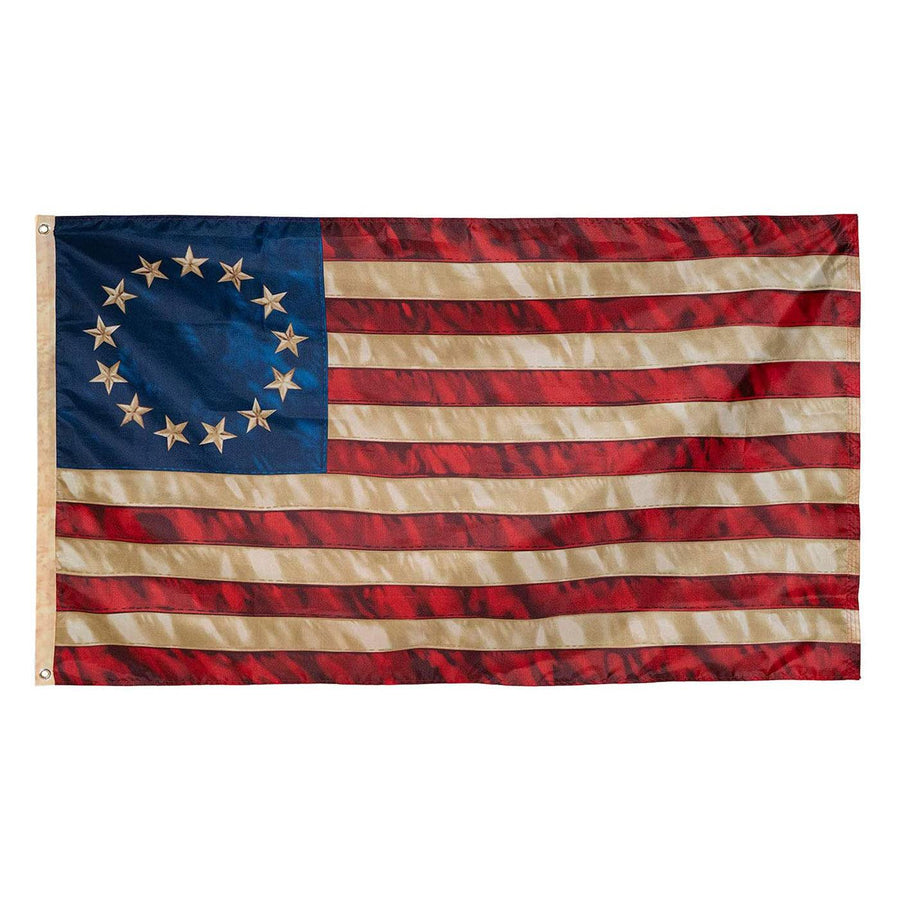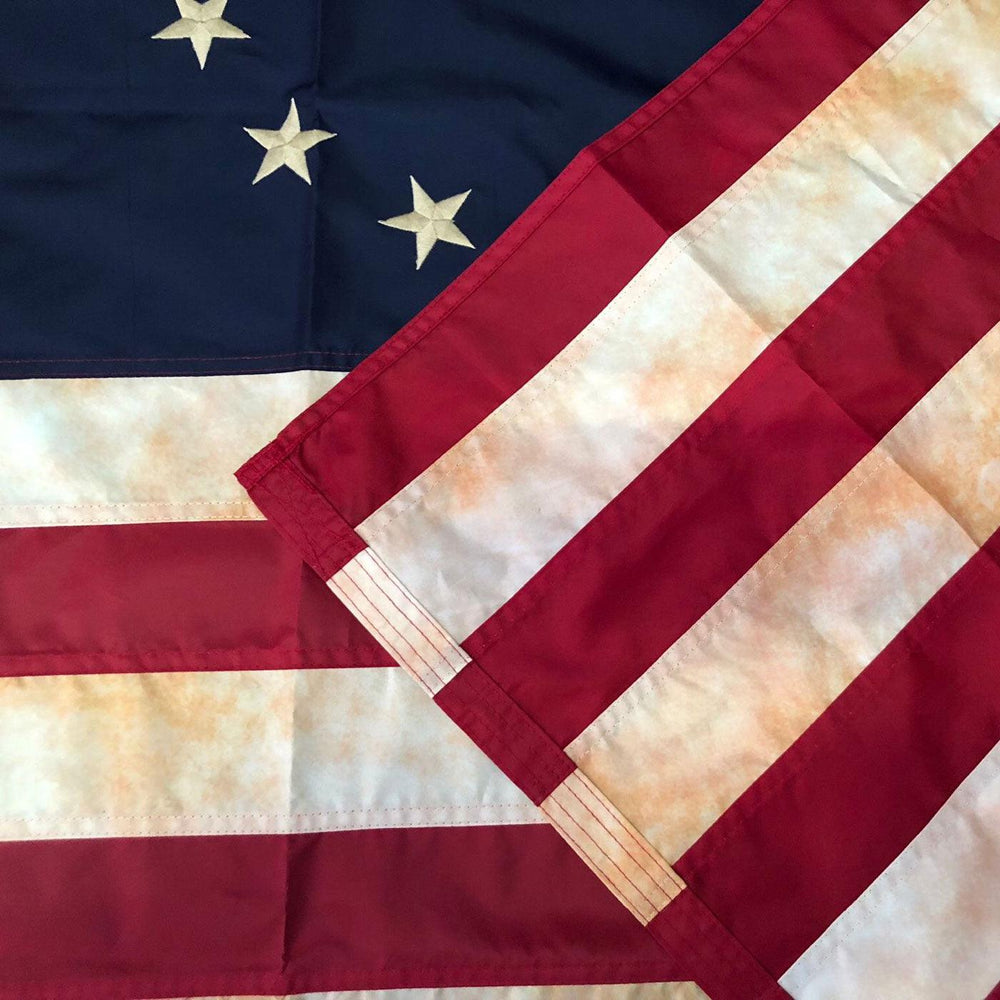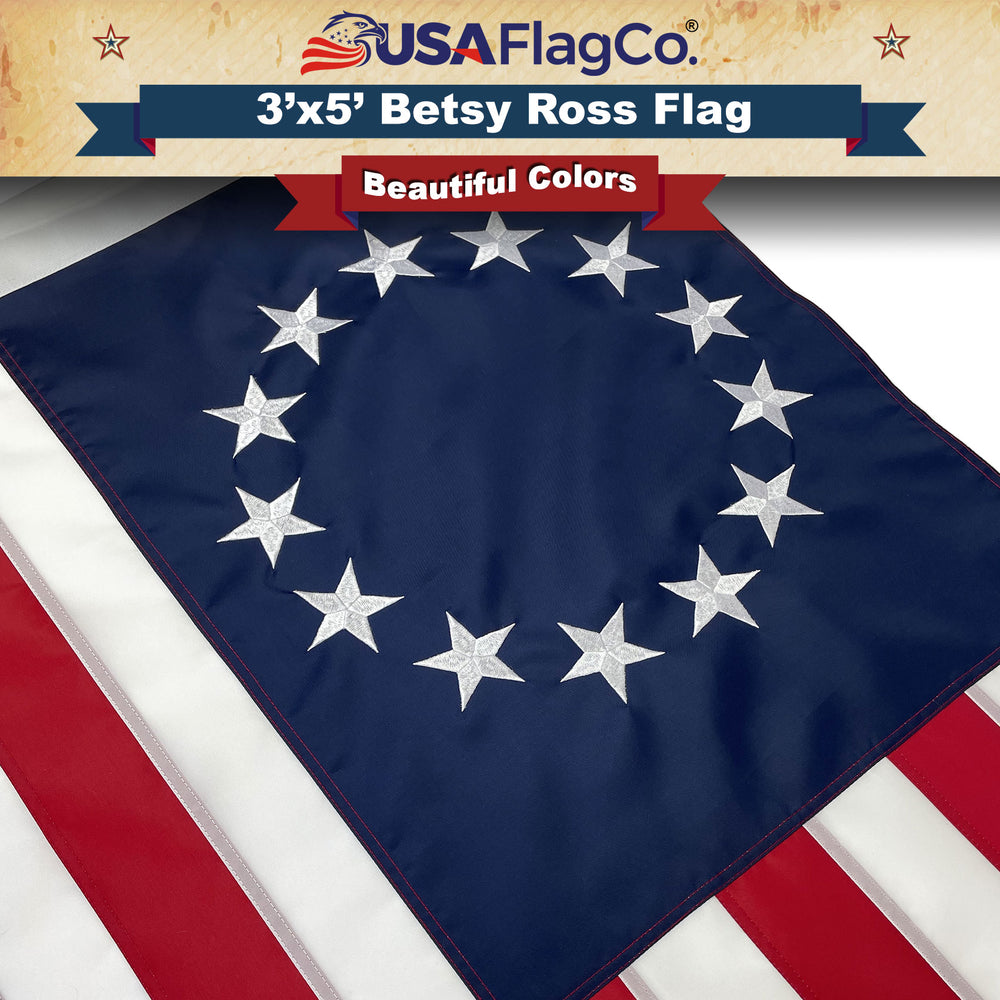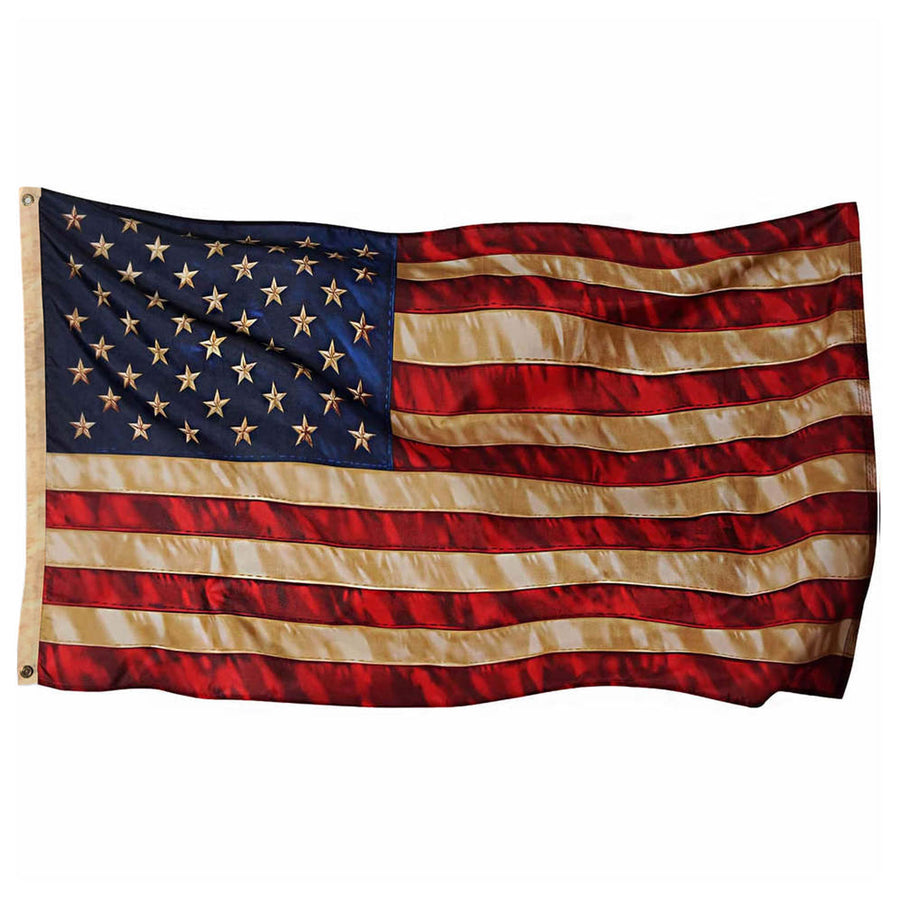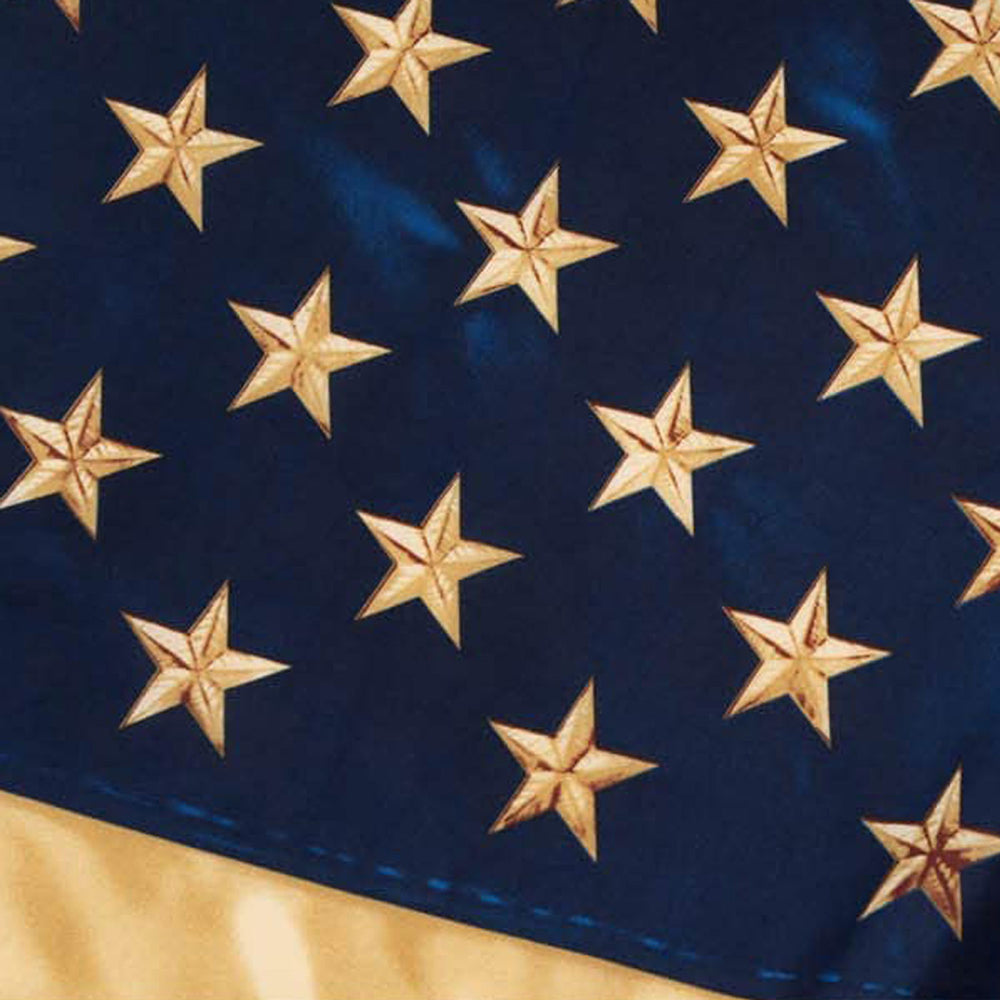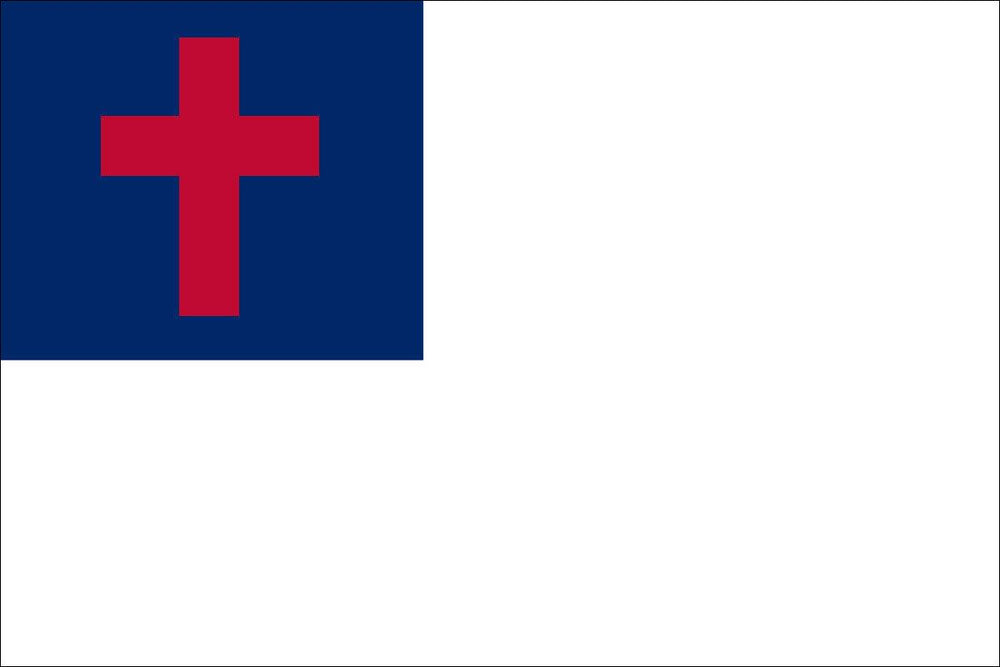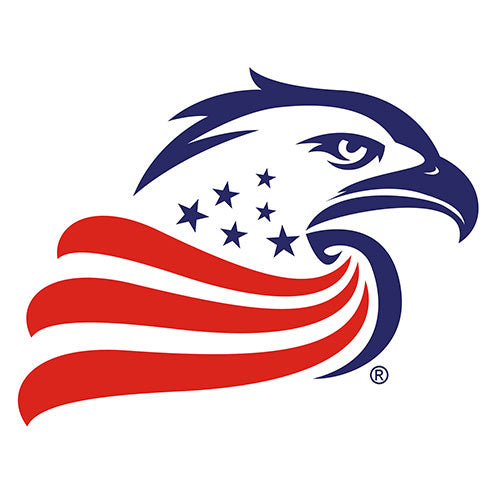Highlights
Fort McHenry Star Spangled Banner Flag
The Fort McHenry Star Spangled Banner Flag, aka the 15-Star and 15-Stripe Flag by USA Flag Co. is manufactured using Embroidered Stars & Sewn Stripes. All USA Flag Co. flags are finished with polyester heading and brass grommets.
Fort McHenry Star-Spangled Banner Flag History
The Fort McHenry Star-Spangled Banner Flag, the fifteen stars and fifteen stripes U.S. Garrison Flag, aka 15 Star Flag flew over Fort McHenry following the Battle of Baltimore in the War of 1812. Seeing the flag during the battle, and again the following morning, inspired Francis Scott Key's song The Star-Spangled Banner, now the U.S. National Anthem.
During the battle a smaller "storm flag" was flown; it was replaced by this larger flag early the next morning, which is the flag Francis Scott Key saw then. This larger flag is now displayed at the National Museum of American History in Washington, D.C. For several decades it remained in the family of Fort McHenry's commanding officer, before being given to the Smithsonian in 1912. The family cut pieces out of the 15 Star Flag from time to time as gifts.
The original Fort McHenry Star-Spangled Banner flag was 42 feet long and 30 feet high, with each stripe being about two feet, and the stars being about two feet in diameter. It was made by Mary Young Pickersgill and her assistants. More info on the original dimensions is here. The stars seem to mostly point to the side, except for one (the bottom right) which points down. One star has been cut out of the actual flag, so I'm guessing that originally pointed to the side as well (Fort McHenry flies a flag with a similar star pattern, but it looks like they are all to the side, and the other dimensions look similar to a modern flag).

GROWTH OF THE FLAG
THE FIRST ALTERATION OF THE STARS AND STRIPES BY CONGRESS.
The Stars and Stripes ordered by Congress in 1777 strongly appealed to the patriotism of the colonists during the remaining period of the Revolution and continued to be the flag of the United States till the first of May, 1795. Vermont was admitted into the Union on the fourth of March, 1791, and Kentucky on June first, 1792. As a matter of course these new States asked to be represented in the flag.
Stephen R. Bradley, the first senator from Vermont, notified the Senate on Monday, December twenty-third, 1793, that on the following Wednesday he should move to bring in a bill to alter the flag so that after the first day of May 1795, it should carry fifteen stars and fifteen stripes.
The bill was introduced on the twenty-sixth of December and was passed by the Senate on the thirtieth. The measure was sent to the House of Representatives for concurrence and was considered on Tuesday, January the seventh, 1794. The House resolved itself into a committee of the whole, and a curious and lengthy debate began on the Senate bill. The leader of the opposition to giving Vermont and Kentucky a place in the National flag was Benjamin Goodhue of Salem, Massachusetts. He was engaged in commercial pursuits, was afterward a senator of the United States, and distinguished himself as chairman of the committee on commerce.
Mr. Goodhue thought the alteration of the flag was a trifling piece of business that ought not to engross the attention of the House when it was their duty to discuss matters of "infinitely greater consequence." He contended that if Congress were to alter the flag from thirteen to fifteen stripes, with two additional stars because Vermont and Kentucky had been added to the Union, it might go on adding and altering at that rate for a hundred years to come. He laid special stress on his idea that the flag ought to be permanent in its number of stars and stripes.
William Lyman of Northampton, Massachusetts, was appointed consul to Liverpool after his congressional term expired and died there in 1811. He was somewhat of a political prophet, and wanted the flag to grow with the Union, and thought it of the greatest consequence not to offend the new States by denying them representation on the flag.
George Thatcher was a member from Yarmouth, Massachusetts, and served many years in Congress, and afterward was Judge of the Supreme Court of his State. He was famous for his wit and had little devotion to the flag. When a bill was reported in Congress respecting the use of the eagle on American coins, he recommended the goose, for which he was challenged to a duel by the author of the bill, but Thatcher's ridicule of the challenge led to its withdrawal. His wit and sarcasm were his chief weapons in opposing the alteration of the flag. He ridiculed the idea of Congress being in so much trouble about the flag, and he charged that the consideration of the matter was a consummate specimen of frivolity. At this rate, he declared, every State should alter its public seal when an additional county or township was formed.
Christopher Greenup of Kentucky (subsequent governor of that State) touched on the keynote of patriotism in saying that he considered it of very great consequence to inform the rest of the world that we had two new States to join the Union. Among the members of the House of Representatives who could see neither patriotism nor justice in the purpose to change the flag, was Nathaniel Niles of Vermont. He was the inventor of the process of making wire from the bar iron; was the judge of the Supreme Court of his State; was a poet and theologian, and expounded the gospel to his neighbors every Sunday, for twelve years in his own house. When the flag bill was before the committee of the whole he expressed sorrow that such a matter should even for a moment have hindered the House of Representatives from going into more important affairs. He did not think the alteration either worth the trouble of adopting or rejecting, but he supposed the shortest way to get rid of it was to agree to it, and for that reason, and that alone, he advised to pass it as soon as possible.
The committee agreed to the bill, and it was taken up by the House.
A large number of representatives in Congress seemed to have no well-defined thought as to the merit of the measure by which the flag was to be changed to correspond to the new condition brought about by the rapid growth of the country. Among such members was Elias Boudinot who, after leaving Congress, was made director of the United States Mint, and for many years was president of the American Bible Society. In his speech before the House, he declared that his only motive in supporting the bill was to keep the citizens of Vermont and Kentucky in good humor.
Mr. Goodhue raised his voice in the committee of the whole against altering the flag. He said he felt for the honor of Congress when spending its time in such sort of business as talking of altering the flag. But since the bill must be passed he had to beg the favor that a record of the proceedings might not appear upon the journal of the House and go into the world as the first of the bills to pass at that session.
James Madison of Virginia, afterward President, favored giving Vermont and Kentucky representation on the flag but made no speech during the remarkable debate.
William Smith of South Carolina, who became a senator, and once refused a place on the Supreme Bench of the United States, stated that the proposed alteration would cost him five hundred dollars, and every American vessel thirty dollars. He could not conceive what the Senate meant by sending them such a bill unless it was the want of something better to do. He said he would indulge them this time, however, but warned the senators against trying to make any more alterations of that kind.
Mr. Smith declared that his conviction was that the flag should remain permanent as to the number of its stars and stripes.
On Wednesday, January the eighth, 1794, the bill passed to a third reading, when Shearjashur Browne of Massachusetts, moved that it be referred to a select committee.
John Watts of New York City, in seconding the motion, stated that his object was to have a clause inserted in the bill to establish the flag of the United States so that in case of new accessions to the Union, future applications for alterations might be precluded. The motion was lost by a vote of forty-nine to thirty-nine when Mr. Watts moved that the bill should be recommitted to the committee of the whole for the purpose of introducing a clause to fix forever the flag of the United States. This motion was likewise lost; and the original bill, providing that from and after the first day of May 1795, the flag of the United States be fifteen stripes, alternate red and white; that the union is fifteen stars, white in a blue field, was passed by a vote of fifty years to forty-two days.
The bill was approved by President Washington on the thirteenth day of January 1794.
The assertion of General Schuyler Hamilton that the stars formed into one large star in the canton, was the flag of 1812, aka Great Star Flag is not sustained on sufficient evidence. It is well known that the Star-Spangled Banner of Fort McHenry had the stars arranged in parallel rows.
NOT ALL FORT MCHENRY STAR-SPANGLED FLAGS ARE THE SAME!
HERE'S WHY...
Extra care is taken in making these flags. Flag designs are researched to ensure that they are authentic and current. We use sturdy fabrics, allowing the flags to be flown outdoors, indoors, or carried in parades.
Constructed with 100% Heavy Duty Nylon (digital dyed) ★ Beautiful, brilliant colors ★ Resistant to wear and tear of sun & rain ★ Complete with heavy canvas heading & brass grommets to meet the most demanding commercial and residential uses.
- All outdoor flags are finished with heavy-duty thread, polyester heading, brass grommets, and four needle fly hem
- Historical flags constructed to precise specifications
- Flies in the slightest breeze
- Proudly Made In The USA
- Beautiful Presentation - This Fort McHenry Star-Spangled Banner Flag makes an excellent gift for friends, parents, or to PROUDLY display on your HOME or OFFICE.
HEAVY-DUTY NYLON OUTDOOR HISTORICAL FLAGS WITH SOLAR SHIELD
Our most popular and versatile outdoor Fort McHenry Star-Spangled Banner flag, USA Flag Co. flags offer the optimum combination of elegance and durability for every purpose. The 100% nylon material provides a rich, lustrous appearance. Our flags have superb wearing strength due to the material’s superior strength-to-weight ratio and will fly in the slightest breeze. Historical flags are finished with strong, polyester canvas headings and spurred brass grommets, and four needle fly hem. The result is a flag that will be flown with pride year after year.
SOLAR SHIELD
- Rich, Vivid Colors
- Durable
- Fire-Resistant
- Mothproof
- Mildew Resistant
- Sheds Water
- Lightweight for Flyability
Add this Fort McHenry Star-Spangled Banner Flag to your cart for Immediate Delivery Now.
Reference:
Our Nation's Flag in History and Incident by Colonel Nicholas Smith, 1836-1911 (PDF) Available online. – 8.07 MB
The History of Our American Flag
30-DAY MONEY BACK GUARANTEE
USA Flag Co. wants you to be completely and perfectly satisfied, and that is why we offer a 30-day money back guarantee from the date you ordered your product(s). Now don't get me wrong, we'd love to know why you didn't like it, but only if you are willing to tell us. Otherwise, it's 100% satisfaction guaranteed return. No questions asked.
We take all the risk out of ordering by offering an unmatched satisfaction guarantee. We'll always do our best to take care of you.
100% SATISFACTION GUARANTEE!
Free standard shipping on orders over $60. Full shipping policy
This product is eligible for returns. Full returns policy
Frequently Asked Questions
This is the most common question asked in the industry and the most difficult to answer. No two flags will wear the same due to weather conditions and how often the flag is flown. Our flags offer the best stitching and highest quality materials to get your flag off to a great start.
Do not hang a flag where the wind will whip it against rough surface, such as tree branches, wires or cables or the outside of your home or building. Inspect your flags regularly for signs of wear. Repair any minor rips or tears right away this can be mended easily with a sewing machine or sewing kit. Keep the surface of the pole free of dirt, rust or corrosion that could damage or stain your flag.
We recommend that you hand-wash your flag with mild soap, rinse thoroughly and air dry. You can also use a dry cleaning service.
Exposing your flag to rain, wind, snow or high winds will shorten the life of your flag considerably. If you leave your flag exposed to the elements, it will greatly reduce the life of your flag.
Yes, as long as your pole is large enough to support the weight of the flags. The USA Flag must always fly at the top. The flag underneath should be at least one foot lower and be one size smaller than the USA Flag. Flags of other countries are not to be flown beneath the USA Flag.
If your flag is significantly faded, torn or tattered it is time to retire your flag. Your flag should be retired privately in a dignified manner. In addition, many local community organizations have flag disposal centers that will dispose of your flag for you.




